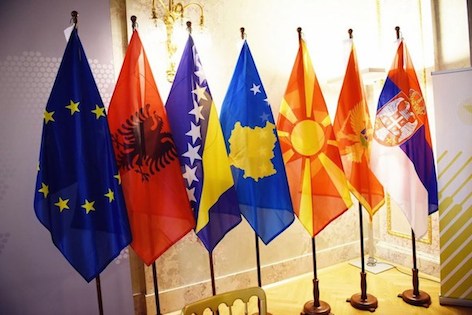

In this short note, we report key-features and economic outcomes of these initiatives, underlining their importance for the development of the countries in the region and their journey toward the EU.
We also report concerns about the actual economic and social prospects in the region, which could undermine the achievements of the SEE 2020 Strategy.
During the Kosovo war (1998-1999), it was felt that a new organization had to be created to overtake the legacies of the past and create conditions for peace, democracy, human rights and economic growth in the Balkans.
Following the initiative of the EU, with Germany as the lead country, the Stability Pact was created on June 10, 1999, in Cologne. With the exception of Serbia and Montenegro – which constituted the Federal Republic of Yugoslavia (FRY) at that time – the countries of the Balkan region were all represented. The text adopted in Cologne was complemented by the Sarajevo Summit Declaration (30 July 1999).
The Pact was envisioned as a regional Marshall Plan with a potential budget of about $30 billion to be spent over a five-year period.
Three working tables and a ‘regional’ one
Basically, the Stability Pact was organized around three working tables:
A fourth table – the ‘regional one’ – coordinated the three working tables.
Key-achievements of Working Table 2
Despite pessimistic views formulated at the very beginning of the Stability Pact process, there were real achievements, especially in the economic sphere. Thus, bilateral free trade agreements (FTAs) were concluded between Balkan countries, and others too. As a result, there was a complex network of 31 bilateral FTAs in the region. These agreements were seen as essential for the recovery of trade between the countries of the region and, as a result, improve conditions for economic growth, the promotion of investment and jobs creation.
In addition, advances were recorded in the field of energy with the participation of the Balkan countries in the Energy Community Treaty.
Other significant actions involving representatives of the private sector concentrated on investment promotion.
In 2006, it was decided to replace the Stability Pact by the Regional Cooperation Council (RCC), namely an institution that became effective in February 2008. The RCC was perceived as ‘regionally owned’ because its members belong to the Balkans – and ownership is essential for lasting outcomes because measures are adopted by members only, and not imposed by foreign powers.
From a trade perspective, the Stability Pact framework would also be replaced by CEFTA 2006. In other words, Balkan countries could become the parties of a ‘renewed’ CEFTA, i.e. the regional agreement that was initially adopted by Poland, Hungary and Czechoslovakia in 1992. Thus, on December 19, 2006, Albania, Bosnia and Herzegovina, Croatia, Macedonia, Moldova, Montenegro, Serbia and the United Nations Interim Administration Mission in Kosovo (UNMIK) on behalf of Kosovo signed an Agreement to amend and enlarge the original Central European Free Trade Agreement.
Considering Kosovo and using the EU as a control group, a 2011 study shows that CEFTA had a positive impact on exports. A separate analysis published the same year and covering the entire CEFTA region is less positive and underlines that there were positive effects at the very beginning of CEFTA, however they vanished overtime because of the evolution of the global economy. Relying on so-called gravity models, other studies show positive impacts on Serbian exports, but no impact at all for Macedonia. Nevertheless, despite seemingly limited impacts, CEFTA 2006 can still be perceived as an effective buffer against external shocks and helps address sensitive trade issues between members.
The SEE 2020 Strategy aims at the strengthening of political and economic cooperation between the countries of the Balkan region within a process that was launched in 2011 and inspired by the EU’s Europe 2020 Strategy.
The strategy relies on five interlinked pillars referring to integrated, smart, sustainable and inclusive growth, and governance; it proposes quantitative regional targets and corresponding measures to achieve these targets.
The overall SEE 2020 targets to be achieved over an eight-year period are:
Moreover, exports of goods and services per capita from the region should increase from EUR 1,780 to EUR 4,250.
It seems too early to assess the achievement of SAA 2020. However, setting goals from a regional perspective without looking at the very specific conditions of each country could be seen as problematic because de facto there are considerable disparities within the region.
Trade between CEFTA members is also impeded by various obstacles. Moreover, considering the persisting high levels of youth unemployment, it is unlikely that one million new jobs will be created by 2020.
Finally, it is worth noting that there are growing concerns about economic and political developments in the region, and the EU policy toward the Balkans.
Conclusion: The importance of external assistance
The Stability Pact created a forum where Balkan countries could develop dialogs and negotiate. It led to the conclusion of numerous bilateral FTAs. CEFTA 2006 permitted to consolidate all these bilateral agreements into a single regional one; it had some positive effects and does represent a buffer against adverse shocks. In line with the EU vision, the SEE 2020 Strategy aims at boosting further the economies of the region; however, its final outcomes are still unclear – eventually, they could be limited, they also raise concerns.
Such a situation may indicate the need for more assistance and resolve to help countries in the Balkans. In that respect, the development of high value-added supply chains within CEFTA should be seen as a top priority to boost economic growth and competitiveness, and create strongly needed jobs.